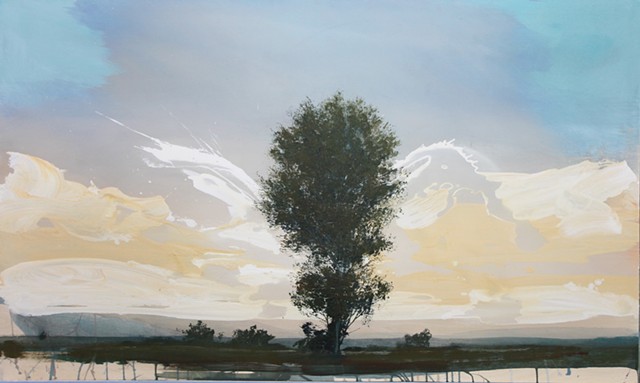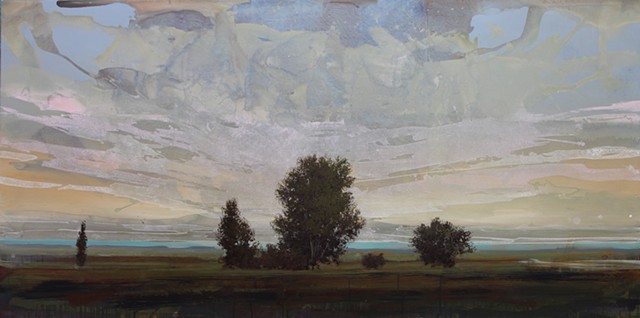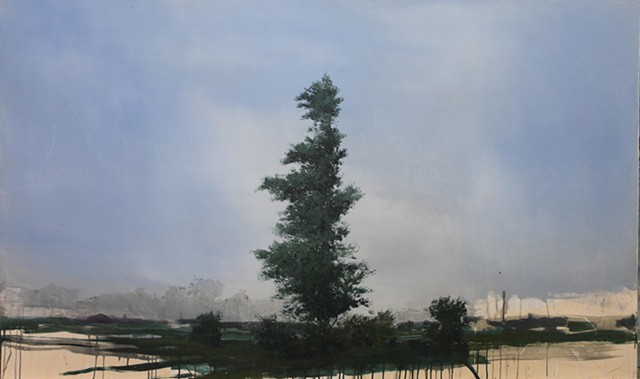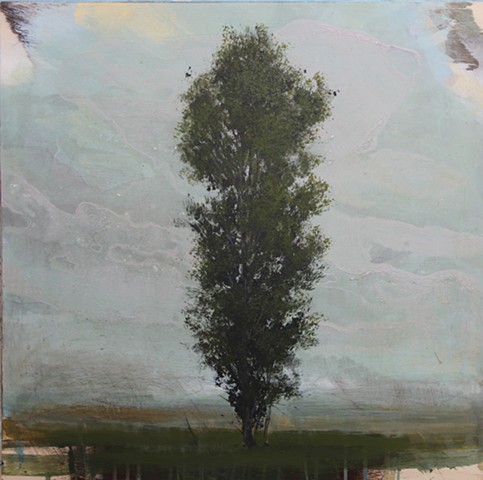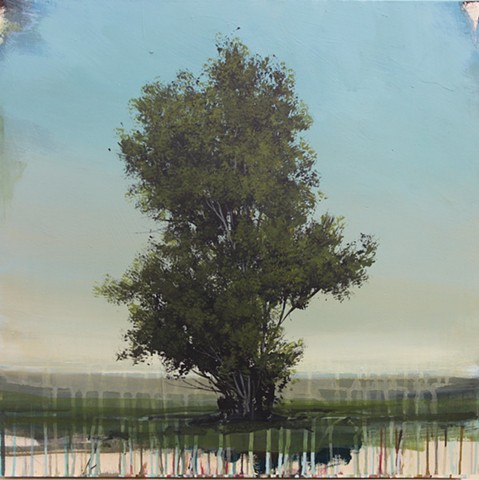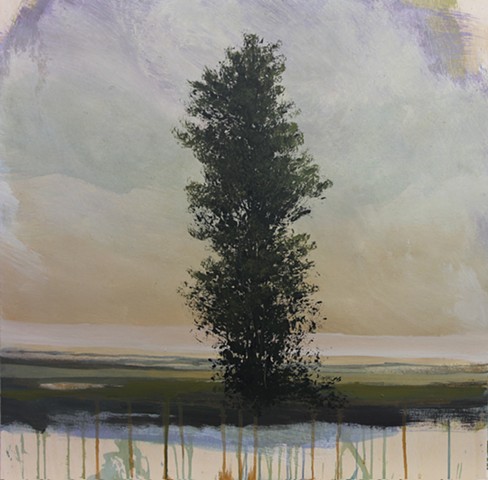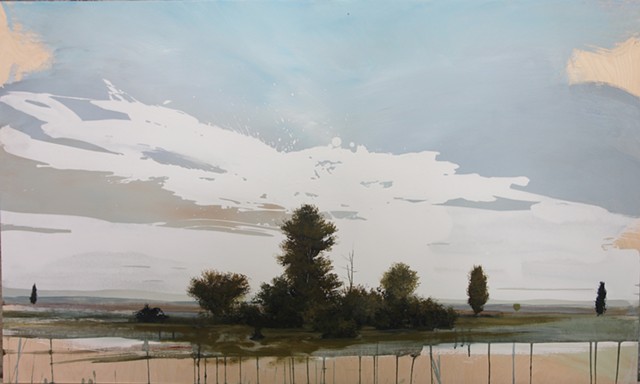Peter Hoffer
Peter Hoffer:
(Syracuse N.Y.,1965) Peter Hoffer has a M.F.A. from Concordia University in Montréal, degrees from the University of Guelph, Ontario, and the Ontario College of Art in Toronto. He has lived and worked in Toronto, New York City, and Montreal where he now resides.
The surfaces of Peter Hoffer’s landscape and abstract paintings are coated with a highly reflective resin varnish. This material was chosen as a means to create tension between a painted surface and refined encapsulation. This packaging of the “objet d’art” stills a moment in space and time and alludes to an item of value, not unlike religious reliquary. This process of exaggerated surface varnishing was extracted from the historical 19th century practice of Parisian-style Salon exhibition. The “vernissage,” which today is known as the “opening,” was a common event among painters to revarnish or shellac their works. This would make the piece refined and give it the appearance of being new and freshly completed. As it were, if the artists painting did not sell, the painting would travel to the next salon and the process would be repeated. For Hoffer, this suggested an unsold painting would be subject to multiple varnishings, and the outer surface of the painting would eventually obscure the image.
Initial works (1996-1999) were created using traditional methods of varnishing. A damar varnish was applied in multiple layers, often 10 to 15, over an extended period of time. Paint was sometimes applied in between certain successive layers creating a sense of depth and dimension.
It was later (2000) that many of the paintings integrated a synthetic resin surface. This at first was used as an outer shell to the piece. An epoxy and acrylic coating was applied over the damar varnish, stablizing it and allowing for a much thicker doming effect. The surface would now be raised from the painting by 1/8 of an inch to as thick as ½ inch.
Inconsistencies including discoloration and surface cracking are intentional and integral to the resin paintings. Many of these works have surfaces with various anomalies within the mixed resins. Surfaces are often layered off center thereby exaggerating the inconsistent topography. Random scratches, sporadic markings and various abrasions may appear throughout the shell of these particular works.
For the artist, this sets up a necessary balance between the naturalness of the painted and organic landscape and the artificial sense of the precious “objet d’art.” A contrast is emphasized between the controlled hand of the artist and the force of the material. In a sense, the painting adopts certain characteristics of the landscape, forever changing and evolving as material breaks down and alters composition.
On several pieces the works were subjected to the extremely cold temperatures of the Quebec winter. The harsh environment etches and stresses the thickly varnished painting prematurely cracking the brittle varnish, and sometimes bleaching and altering the structure of the surface.
THE LANDSCAPE
Reference is made to theatrical backdrops. The rapid execution of these paintings creates a generalized suggestion of a place or setting. The viewer is both the actor in the scene and becomes a player within a scenario where the trees and landscape are personified and situated within the stages.
A notion of pending drama looms in the err of these works. The time of day or location of the “self” are called into question as the viewer sees beyond the distraction of the glossed surfaces.
DIVIDED SURFACES
This current series of landscapes further exaggerates the separation of scenic perspective through the literal division of the painting’s surface. Although the surfaces are divided into 2 or 3 sections, they are in fact assembled and painted together.
When assembled within an exhibition, the separation between each individual piece falls into a chapter. A continuity is created through the play of painted surface, against the parameter of each painting’s structure. When one divided painting is positioned next to another, the part is seen as a whole.
MARTYRS
PETER HOFFER: MARTYRS
Peter Hoffer captures wrecks on a highway in an age where the image is the reality. The context is the image. Nature stands witness to it all, surrounds, permeates it all. The latest paintings are at once landscapes, peopled by highway scenes of tractor-trailers, sometimes on the road, other times laid out like corpses in a variety of situations. These paintings are a departure from earlier landscape, or action abstract fusions Peter Hoffer focused on earlier in his career. For the landscapes, and the events integrated into these paintings, they have a Romantic picturesque flair to them. Each painting incorporates imagery from tractor-trailer highway crashes, but they are serene, unspoken memorials to these events. Hoffer’s paintings have no people in them, just the bodies of the tractor-trailers, abandoned. These eulogies to the transport haulers of our age, the lifeblood of our economy, animate using the forms and shapes, and the situations they have been captured in. The placement of the vehicles in each scene, from close-up to farther away, is central to and an important feature of the painting. The dialogue then, is between nature and the man-made world. These vehicles are sited in, surrounded by, effectively set into nature.
Landscape becomes a contextual framework and has no actual time bound or realist linkage, aside from the signage, the signology of the highway. These long haul transports have a presence that is all there, and their “bodies: are eloquent, and very much of our times. Like J. M. W. Turner’s Shipwreck in the Tate Gallery, Hoffer’s paintings surround their subjects with all of nature’s weather. Nature is a constant backdrop, and nature is the ever-changing situation within which these tractor-trailer carriages and cabs are situated just as it was for the Romantic painters. Memory of place, memory of experience, and the ongoing dislocation of context are reference d in these paintings, but with all the naturalistic painting style and continuity that speaks of what painting is all about as a medium for communication.
Peter Hoffer paints scenes of potential tragedy, and the corpses of these trucks and tractor-trailers are like unrepentant behemoths. Hoffer captures these scenes with a sense of the place, something not common to our era. There is something of that spirit of Romanticism where nature looms large, and God’s eye is on the land or sea. The universe exists in the details the Romantic painters and poets captured. Turner’s Shipwreck (1805) exhibited in his own gallery at Petworth could have been inspired by William Falconer’s highly popular 1762 poem about the sinking of the ship Earl of Abergavenny. Trucking is now the lifeblood of post-industrial consumer capitalism, just as shipping was for commerce in the days of the British Empire. Shipwrecks and other disasters at sea were a persistent theme in Romantic painting that expressed the primal force of the elements and nature. These paintings engage in a historical continuity of art in an open and natural way, something unusual in the confusing new media craft and manufacture oriented art world of our times.
As expressions of nature’s omnipresence, and the Romantic notion of the sublime and the way it objectifies, even commodifies nature, Peter Hoffer’s paintings rephrase it all, jumpstarting it for a postmodern era where the video clip and the scene of a crash is time compressed by media rather than timeless. Caught in a moment to be replaced by another image, news footage shaped into its microdocument format seems as fictional as it is scenaristic. From majestic commentary on the power of nature to video clip, sublimity is now compressed, condensed, and reframed. Instant erasure becomes part of the process of image consumption.
Romanticism involved a sublime sense of the spectacle of nature and of the ages past or present. Nature as subject for art was objectified for ready exploitation, even as it looked or felt sublime to the viewer. Antiquity and the glories of the past played a role in it all. With Hoffer’s paintings nature is there, but with an acute sense of the times we live in. For all the environment in these scenes, nature is denaturized. These stark unfolding and crumpled trucks laid down in the landscape make us curious. How did this happen? What was the event? What occurrence? The state of contemporary culture is much like these paintings. Contexts are isolated and the world we live in is less about the physical tactile places we live in than the images that are edited, captured and replayed to us all.
Now the image is the context. Just as the serenity and sublime beauty of nature was so central to Hoffer’s Eden exhibition of paintings, the fusion of nature into contemporary art, for Hoffer involved reconfiguring and re-historicizing nature for world we live in. Nature is a backdrop in all these new paintings, and is ever present and changeable. These paintings do not attempt the illusionistic SuperRealist style of Richard Estes. Instead Hoffer captures a naturalism and serenity, despite the tragic nature of many of these mediatic landscape paintings. Landscape becomes a window on the world with all its sublime associations. Instead of Caspar David Friedrich’s Icebergs from the Romantic era, each of these paintings has a man-made transport vehicle reconfigured in a sublime way.
Andy Warhol’s Car Crash series (1962-64) of burning cars, macabre have a different point of departure from Peter Hoffer’s Martyrs who personify the vehicle, rendering it a symbol of something human, but also larger than life. Green Car Crash (Green Burning Car I), created by Warhol and assistant Gerard Malanga was based on a that appeared in the June 3, 1963 issue of Newsweek by photographer John Whitehead. The photo documented a police chase in Seattle where the crash car overturned at 60 m.p.h. The driver flew from the car and his body caught on a utility pole climbing spike. Hoffer’s Martyr series are comparable to the painter Andy Warhol’s Car Crash series, but these paintings are less about the spectacle than the objectified scene. The presence of these transport vehicles is one of abandon, and the reference to Martyrs, albeit religious, is ultimately about the notion of sacrifice, but as an idiom of, not real sacrifice. Any social, aesthetic and personal constructs of nature Peter Hoffer uses are quintessentially North American. For Andy Warhol it was the spectacle. For Hoffer, it is that constant context of nature and of the interweaving of machine with environment and weather.
Whether tragedy or modern day reality, tractor-trailer crashes are very much part and parcel on the supply demand distribution systems of late or post-Capitalist economies. Peter Hoffer does not exaggerate, or transfer these scenes drawn from a variety of sources or build them into hyper-realist perfectionist thematic scenarios. Instead, these scenes are pure painterly interpretations. What we do not see is the people involved. Like dinosaurs these behemoths spread across the landscape like the bodies in religious retableaux. As eulogies to an event they almost have the character of human bodies, these sacrificial vessels of hyperconsumerism. Some of the tractor-trailers are completely turned over, like sacrificial emblems. St. Thomas has its piping extending out into the distance amid a stormy sky. In St Eulalia the truck is set into a Group of Seven-ish landscape in mid-winter completely entombed in a snowscape. St. Paul is a tractor-trailer pure and simple without any event. It stands ceremoniously ready for the road. The metal surface of the white truck in Santa Margarita is crumpled like tissue in the middle of a highway reminiscent of Jack Chambers’ 401 Towards London No. 1 (1968–1969), a view of the Highway 401 heading westward towards London in southwestern Ontario. Less well known is the fact that Jack Chambers’ rough styled 80-minute film The Hart of London (1970). In that film disaster scenes from newsreels with nature imagery, just as Hoffer does in his most recent series. There is nothing new to this.
In Hoffer’s piece the placement of the Highway sign, the yellow centre of road markings, blue sky and horizon line all make it akin to a landscape as still life. In St. Lucia the roof of the truck faces the viewer, and surrounded as it is by sky and highway, is the central presence in the painting. The undulating red metal shadings, gradations make it, for all intents and purposes like a Mary Pratt still life Salmon on Saran (1974). Grain that falls out of the truck references St. Lucia’s place as Saint of agriculture. Here, however, the truck as object is extended into the scale of landscape painting. Still another has a front of clouds extending in a line almost following the line of the tractor-trailer’s edge as it rests on the land.
Unlike Hoffer’s previous paintings, the Martyr series is less about nature per se than they are about the process whereby we codify, recognize and reconfigure nature. In so doing nature acquires a meaning that surpasses the real experience. In art the same can be true. Figurative elements such as fields, trees, land, highway and sky vistas represent nature as it is in a painterly way. Hoffer provides us with clues to the inherent context and meaning that a landscape holds as a social construct. We will often build our vision of a landscape or any scene for that matter based on the way reality can be edited and modified. The process is akin to religious and landscape painting from other epochs, in that it heightens our vision of what that reality represents. The image builds the reality just as the media codifies, condenses and crop imagery. Nature no longer represents God’s dominion as it did for the Romantics. Instead, it is the absence of direct experience nature, or even the incidents we read of such as these, that reduces nature to a set of variables we interpret without reference to any experience we may live. Inadvertently this is what Peter Hoffer’s paintings reference, but with an open and inquiring eye for synchronicity of event, reality and image.
These dematurized, decontextulized tractor-trailers exist in paradigms of nature that invoke a painterly space. Nature becomes a context, reconfigured in a contemporary scene with all the surface painter’s effects. Light plays a central role in these paintings, it surrounds these scenes and animates the surfaces of the trucks. Nature is edited down, where the colour scale and elements are more limited than any reality ever is or was. Like stage sets, where each element can be moved, replaced, or re-moved, they reconfigure our sense of what nature is or could be, adapt it in time. They paintings catalyze contemporary notions of nature and art, reconfiguring it all into images of a nature that is an ideal far from the world we actually live in with its intertwining of the man-made and natural.
Peter Hoffer’s Martyrs are very much about the painterly process. Like memories transfixed in time. There is a dialogue between nature and the contemporary mediatic experience that is slightly unsettling. The real life experience develops the scenario, while painting establishes the aesthetic dimensionality of the scene. As paintings, the Martyrs evidence a process of denaturization our culture where contexts are endlessly shifting entities. Even as these paintings reference that noman’s land of media culture, they never adopt the fatalism of its process. Instead Hoffer’s Martyrs introduce an undercurrent of nature. Is this a Romanticism reconfigured for a post-Mediatic world ? As Peter Hoffer paints these larger-than-life behemoths of the transport industry, situating them, recontextualizing them as art, he challenges the conceptual bias of today’s art. In so doing he is reintroducing a subtle and ongoing dialogue with history, with the history of painting, as an ever evolving process that embroiders on the way art develops a visuality, that refies reality, while perpetually reinventing itself from generation to generation, epoch to epoch. These themes are universal.
John K. Grande
John K. Grande is the author of Art Nature Dialogues: Interviews with Environmental Artists (State University of New York Press, 2007) and Dialogues in Diversity: Art from Marginal to Mainstream, Pari Publishing, Italy, 2008 (www.paripublishing.com). He is co-author of Bob Verschueren: Outdoor Installations (Editions Mardaga, Brussels, 2010) and recently co-curated Eco-Art with Pia Hovi-Assad and Peter Selz at the Pori Art Museum in Finland (2011). www.grandescritique.com. His most recent book Homage to Jean-Paul Riopelle was published in 2011 by Gaspereau/Prospect Press.
EXHIBITIONS
2013
“Peter Hoffer; New Works”, Gruen Galleries, Chicago, IL, April 19 --
June 6.
2011 “Stations of the Cross”, Oil paintings, Nicolas Metivier Gallery, Toronto, ON, June 23 – July 30.
2010
INTERVENTION – Recent Paintings, Galerie Simon Blais, Montréal, Sept. 15 – Oct. 30, 2010.
2008
Interior Garden, Galerie Laura Bresteau, Brussels, Belgium; L’Histoire Naturel, Galerie Kerstin Blaschke, London U.K.; Recent Paintings. Galerie Catherine Bombard, Paris, France; “L’Histoire Naturel”, Galerie Simon Blais, Montreal; “PROSE” Nicolas Metivier Gallery, Toronto, Ontario, January–March; Studio 21 Halifax, N.S. January-March; Landscapes. Chase Gallery. Boston, MA. June – July; New Paintings. Bau-Xi, Vancouver, B.C. September-Oct.; Divide, Galerie Simon Blais, Montréal, Québec.
2007
New Paintings. Mary Bell Gallery, Chicago; “Element”, Nicolas Metivier Gallery, Toronto; “Stigmata”. Kathryn Markel, New York; Stricoff Gallery, New York.
2006
“Terrain” Nicolas Metivier, Toronto; “Common Ground”, Kathryn Markel. New York; New Art, Perry Nicole Gallery, Memphis TN; “Summertime in Paris”, Parisian Laundry, Montreal.
2005
Galerie Simon Blais, Montreal, Quebec; Recent Paintings, Bau-XI Gallery, Toronto, Ontario; Galerie St-Laurent-Hill, Ottawa, Ontario; Parisien Laundry, New Painting, Montreal Quebec.
2004
Recent Paintings, Galerie St-Laurent-Hill, Ottawa; Gallery Bau XI, May 29 – June 30, Vancouver, B.C.; “The In Between”, Newzones, Calgary, Alberta.
2003 Musée de Las Arts de L’Université de Guadalajara, Mexico; Galerie Art Mur, Montréal, Québec; Galerie Simon Blais, Montréal, Québec. “Zones D’Experience” Musee Du Quebec.
2002
Centre National d’Exposition de Jonquiere, Quebec; Galerie St-Laurent-Hill, Ottawa, Ont.; “Invitation Au Voyage”, Maison de la Culture, Montreal, Québec.
2001
Exposition les Collection Perminante, Maison des Arts, Laval, Québec; Teodora Gallery, Toronto, Ontario; “Distance”, Galerie Port-Maurice, Saint-Leonard, Québec.
2000
Galerie Simon Blais, Montreal.
1999
Galerie Simon Blais; Group Exhibition, Convergence International Arts Festival, Providence, Rhode Island; “Metamorphose”, Salle Alfred-Pellan, Laval, Québec.
1998
Centre De Créativité Des Salles Du Gesù, Montréal, Québec; Rotunda Gallery, Kitchener City Hall, Kitchener, Ontario
1997
Bourget Gallery, Concordia University, Montréal, Québec. Solo Exhibition, Artifice Gallery, Syracuse, New York.
1996
Group Exhibition, Leonard and Bina Ellen Gallery, Montréal, Québec. Solo Exhibition, “L’Histoire Presentée,” Espace 440, Montréal, Québec; Installation, Complex Du Canal, Lachine, Québec; Outdoor Public Exhibition, “Retro Architectural Models”, Lachine, Québec.
1995 Installation, “Birdgathering”, Concordia University, Montréal, Québec; Graduate Student Exhibition, Concordia University, Montréal, Québec.
1994
Group Exhibition, Carol Freidman Gallery, New York, N.Y.; Solo Exhibition, Artifice Gallery, Syracuse, New York.
1993
Solo Exhibition, “Extensions”, Zavitz Gallery, University of Guelph, Guelph, Ontario; Installation, “Extensions”, Hamilton Harbourfront, Hamilton, Ontario; Installation, Laurel Conservation Area, Waterloo, Ontario; Exhibition of Area Artists, Guelph Civic Museum, Guelph, Ontario; Installation, Arboritum, Guelph, Ontario.
1992
Group Exhibition, Toronto City Hall; Solo Exhibition, Kitchener-Waterloo Art Gallery, Kitchener, Ontario; Solo Exhibition, “12 Paintings”, Zavitz Art Gallery, Guelph, Ontario; Group Exhibition, “Recent Paintings”, McCaul Building, Ontario College of Art, Toronto, Ontario; Group Exhibition, Area Artists, Kitchener-Waterloo Art Gallery, Kitchener, Ontario.
1991
Group Exhibition, Galerie La Reja, Beausoleil, France; Solo Exhibition, Waterloo Public Library, Waterloo, Ontario.








